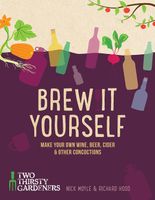Label
All
0
Clear all filters
Save 25% on ckbk Premium Membership with code FALLFLAVORS 🍁
Sterilization
Appears in
By Richard Hood and Nick Moyle
Published 2024
We’ll start with THE most tedious part of the process, but arguably the most important. Months of work can be wasted by contamination from a dirty bottle or piece of equipment, so all items that come in contact with your precious brew – before, during and after making it – must be cleaned thoroughly before use.
There are various chemicals on the market that will do this (our choice is VWP Cleaner, available in powdered form from homebrew shops in various sizes of tub). To sterilize your kit, simply dissolve the powder in warm water following the pack instructions, and briefly soak everything that will come into contact with your drinks in the solution before rinsing it through with water. The rinsing stage is important, as chemical aftertastes can taint a brew just as effectively as a grubby funnel. It is also wise, though not vital, to sterilize your cider- and wine-making ingredients to kill off unwanted yeasts and bacteria before any fermentation begins. This can be achieved by dropping a Campden tablet (which needs crushing; two teaspoons make perfect crushers) into your ingredients 24 hours before adding the yeast. This can also help ward off oxidization, so Campden tablets are often added to wine before bottling. However, Campden tablets come with a cautionary note: they’re made up of sodium metabisulphite, which one out of every 100 people is sensitive to (the effects cause asthma-like symptoms) – hence the ‘contains sulphites’ warning on many wine and cider labels. You should check with your guests before sharing any sulphited drinks.
Become a Premium Member to access this page
Unlimited, ad-free access to hundreds of the world’s best cookbooks
Over 160,000 recipes with thousands more added every month
Recommended by leading chefs and food writers
Powerful search filters to match your tastes
Create collections and add reviews or private notes to any recipe
Swipe to browse each cookbook from cover-to-cover
Manage your subscription via the My Membership page
Best value
Part of
Advertisement
Advertisement
The licensor does not allow printing of this title


